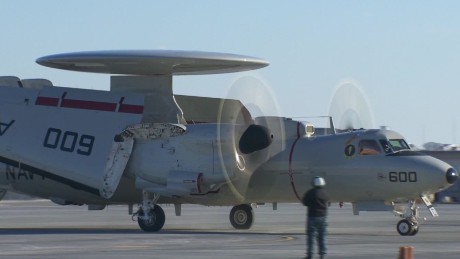Chinese ships sail near disputed Japanese islands
Story highlights
- Chinese ship movement comes days after US defense secretary's visit to Japan
- US defense chief said Senkaku Islands part of US-Japan security treaty
(CNN)Three Chinese Coast Guard ships entered waters near a chain of islands claimed by both China and Japan in the East China Sea on Monday, according to authorities from both sides.
Japan controls the chain and calls them the Senkaku Islands, while China calls them the Diaoyu Islands.
The sailing comes just days after US Defense Secretary James Mattis reaffirmed America's commitment to defending Japan and its disputed islands.

A Chinese Coast Guard ship in waters near a chain of islands claimed by both China and Japan in the East China Sea.
According to Japanese broadcaster NHK, protests were lodged with the Chinese Embassy in Tokyo and in Beijing through the Japanese Embassy.
Tensions have flashed numerous times in recent years over the disputed islands, including face-offs between Japanese and Chinese air and naval forces that have been termed dangerous by both sides.

This aerial shot taken on September 15, 2010, shows the disputed islands, known as Senkaku in Japan and Diaoyu in China, in the East China Sea.
China's State Oceanic Administration, which oversees the country's Coast Guard, put out a statement late Monday saying the three ships "cruised within China's Diaoyu Islands territorial sea."
China's Defense Ministry, which is separate from the Oceanic Administration, posted a statement on its website confirming the Coast Guard ship movement.
Japan's Coast Guard said the Chinese vessels spent two hours in Japanese territorial waters.
It was the fourth time Chinese ships have entered Japan's waters this year, the Japanese Coast Guard said. There were 36 such incidents in 2016, it said.
Despite the frequency of the Chinese sailings, experts said having one so soon after Mattis' visit to Japan sent a subtle message to both Tokyo and Washington.
"It is both a signal that China won't be intimidated from defending its interests/claims and a test to see how the new (Trump) administration responds," said Carl Schuster, a professor at Hawaii Pacific University and former director of operations at the US Pacific Command's Joint Intelligence Center.
Denny Roy, an Asian security expert at the East-West Center in Honolulu, said ship movements in disputed waters could result in a shooting incident.
"The danger is especially high considering military personnel on both sides are often eager to demonstrate their determination to defend what they consider national territory," Roy said.
And a China-Japan military confrontation could bring US forces into play.
During a press conference Saturday in Tokyo, Mattis said the US would defend the islands with Japan.
"I made clear that our long-standing policy on the Senkaku Islands stands -- the US will continue to recognize Japanese administration of the islands and as such Article 5 of the US-Japan Security Treaty applies," Mattis said in an appearance with Japanese Defense Minister Tomomi Inada.
The US position was reinforced Tuesday in a phone call between Japanese Foreign Minister Fumio Kishida and the new US Secretary of State Rex Tillerson, according to a statement from Japan's Foreign Ministry.
"The United States will be against any unilateral action made to damage the Japanese administration of the Senkaku Islands," Tillerson stated during the call, according to the Japanese statement.
China responded quickly on Saturday to the US stance on the islands, saying it brings instability to the region.
"Diaoyu and its affiliated islands have been Chinese territory since ancient times. These are historical facts that cannot be changed. The so-called US-Japan security treaty was a product of the Cold War, and it should not harm China's territorial sovereignty and legitimate rights," Chinese Foreign Ministry spokesman Lu Kang said in a statement.
"We urge the US side to adopt a responsible attitude and stop making wrong remarks on the issue of the sovereignty of Diaoyu Islands," Lu said.
The US commitment to the Senkakus is not new. In 2014, the Obama administration also said the remote chain fell under the treaty.
In late 2013, China declared an air defense identification zone (ADIZ) over much of the East China Sea, including the Senkakus, despite objections from Tokyo and Washington.
Japan also has an ADIZ over the islands. Although the Senkakus are uninhabited, their ownership would allow for exclusive oil, mineral and fishing rights in the surrounding waters.
While the Senkakus remain a source of friction in the US-China relationship, Mattis' visit seemed to have soothed relations a bit in another area, the South China Sea.
Although the US defense chief said "China has shredded the trust of nations in the region" by fortifying disputed South China Sea islands, Mattis also said no increased US military maneuvers there were needed.
Lu, the Chinese Foreign Ministry spokesman, on Monday welcomed that stance.
"As for Mattis' comment that there is no need for large-scale military operations in the area and the issue should be resolved through diplomacy, these remarks deserve our affirmation," Lu said.
















No comments:
Post a Comment
Comments always welcome!